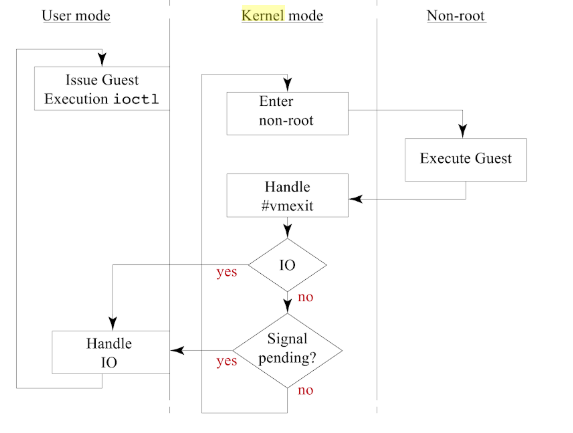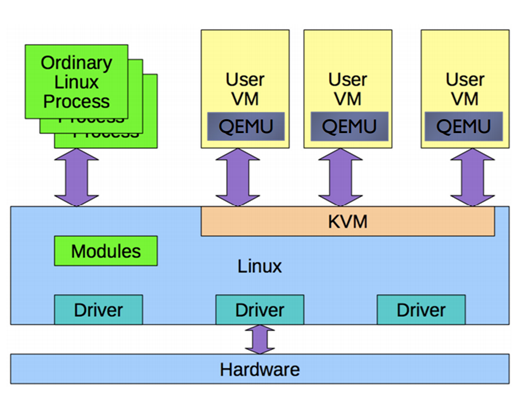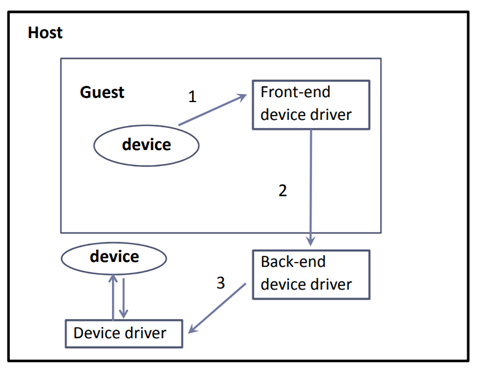instruction set to provide isolation of resources at hardware level. Since Qemu is a userspace process, the kernel treats it like other processes from the scheduling perspective.
Before we discuss Qemu and KVM, we touch upon Intel Vt-x and the specific instruction set added by vt-x.
Vt-x solves the problem that the x86 instructions architecture cannot be virtualized.
Simplify VMM software by closing virtualization holes by design.
Ring Compression
Non-trapping instructions
Excessive trapping
Eliminate need for software virtualization (i.e paravirtualization, binary translation).
Adds one more mode called the non-root mode where the virtualized guest can run. Guest doesn’t necessarily have to be an operating system though. There are projects like Dune which run a process within the VM environment rather then a complete OS. In root mode it’s the VMM which runs. This is the mode where kvm runs.
Transitions take place between the non-root mode to root mode via a VM exit and similarly from root mode to non-root mode via a vm entry. The registers and address spaces are swapped in a single atomic operation.


Qemu runs as a user process and handles kvm kernel module for using the vt-x extensions to provide the guest an isolated environment from memory and cpu perspective.
This is how it looks like


Qemu process owns the guest RAM and is either memory mapped via file or anonymous. Each vcpu provided to the guest runs as a thread on the kernel. This gives the advantage that the vcpu are scheduled by the linux scheduler like any other threads. The difference is just the code which gets executed on those threads. In the case of guest since it’s the machine which is virtualized, the code executes software BIOS and also the operating system.
Qemu also dedicates separate thread for I/O. This thread runs an event loop and is based on the non blocking mechanism and registers the file descriptors for i/o. Qemu can use paravirtualized drivers like virtio to provide guests with virtio devices like virtio-blk for block devices and virtio-net for network devices.


Here you see Guest within the Qemu process implements the front end driver where as the Host implements the backend drivers. The communication between front-end and back-end driver happens over specialized data structures called virt-queues. So any packet which originates from the guest is first put into the virt queue and the host side driver is notified over a hypercall, to drain the packet for actual processing to device. There can be two variations of this packet flow.
- Packet from guest received by Qemu and then pushed to backend driver on host. Example being virtio-net
- Packet from guest directly reach the host via what is called a vhost driver. This bypasses the Qemu layer and is relatively faster.
Also there is a hotplug capability to make the devices dynamically available in the guest. This allows to dynamically resize the block devices as an example. There is also a hotplug-dimm module which allows to resize the RAM available to the guest.
Finally creation of a VM happens over a set of ioctl calls to the kernel kvm module which exposes a device /dev/kvm to the guest. In simplistic terms these are the calls from userspace to create and launch a VM
KVM CREATE VM : The new VM has no virtual cpus and no memory
KVM SET USER MEMORY REGION : MAP userspace memory for the VM
KVM CREATE IRQCHIP / …PIT KVM CREATE VCPU : Create hardware component and map them with VT-X functionalities
KVM SET REGS / …SREGS / …FPU / … KVM SET CPUID / …MSRS / …VCPU EVENTS / … KVM SET LAPIC : hardware configurations
KVM RUN : Start the VM
KVM RUN starts the VM and internally it’s the VMLaunch instruction invoked by the kernel module to put the VM code execution in non-root mode and post that changing the instruction pointer to the location of code in guest memory. This might be an over simplification as the module does much more to setup the VM like setting up VMCS(VM Control Section) etc.
Disclaimer : The views expressed above are personal and not of the company I work for.